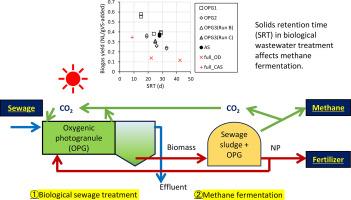Effect of solids retention time on wastewater treatment and methane recovery by oxygenic photogranules
Q1 Environmental Science
引用次数: 0
Abstract
Oxygenic photogranules consisting of bacteria and microalgae offer a feasible wastewater treatment technology owing to their good settleability and energy efficiency, especially through self-aeration. Anaerobic co-digestion of sewage sludge and grown photogranules is promising for more energy recovery, but the effect of solids retention time and inorganic carbon loads on photogranules for methane recovery is uncertain. Laboratory-scale photogranules and conventional activated sludge reactors were operated in a continuous mode under different solids retention times and inorganic carbon and nutrient loads. Anaerobic digestion of waste photogranules and waste activated sludge yielded approximately 0.3 NL/g-volatile-solids-added of biogas at 19–29 d of solids retention time of biological wastewater treatments. Biogas yield increased at 15 d of solids retention time, but wastewater treatment performance was deteriorated. The waste biomass generation rate relative to total organic carbon in the influent was 28 % for the activated sludge, 69 % for photogranules, and 80 % for photogranules with addition of inorganic carbon. Biological wastewater treatment by photogranules demonstrated potential to achieve a 2.9-fold increase in waste biomass yield compared to that of activated sludge with the addition of inorganic carbon. The present study is limited to stable laboratory conditions of synthetic wastewater and temperature but offers technical insights on developing photogranule systems with anaerobic digestion as efficient wastewater treatment and bioenergy recovery.

固相停留时间对氧光颗粒处理废水及甲烷回收的影响
由细菌和微藻组成的氧光颗粒具有良好的沉降性和能源效率,特别是自曝气性,是一种可行的废水处理技术。污泥与生长的光颗粒厌氧共消化有望获得更多的能量回收,但固体停留时间和无机碳负荷对光颗粒甲烷回收的影响尚不确定。实验室规模的光颗粒反应器和常规活性污泥反应器在不同固体停留时间、无机碳和养分负荷下连续运行。在废水生物处理固相滞留时间为19 ~ 29 d时,废光颗粒和废活性污泥厌氧消化产生的沼气挥发性固相添加量约为0.3 NL/g。固相停留时间为15 d时,沼气产量增加,但废水处理性能下降。相对于进水中总有机碳,活性污泥的废物生物量生成率为28%,光颗粒为69%,添加无机碳的光颗粒为80%。与添加无机碳的活性污泥相比,光颗粒生物废水处理具有实现废物生物质产量增加2.9倍的潜力。目前的研究仅限于稳定的合成废水和温度的实验室条件,但为开发具有厌氧消化的光颗粒系统作为有效的废水处理和生物能源回收提供了技术见解。
本文章由计算机程序翻译,如有差异,请以英文原文为准。
求助全文
约1分钟内获得全文
求助全文
来源期刊

Bioresource Technology Reports
Environmental Science-Environmental Engineering
CiteScore
7.20
自引率
0.00%
发文量
390
审稿时长
28 days
 求助内容:
求助内容: 应助结果提醒方式:
应助结果提醒方式:


